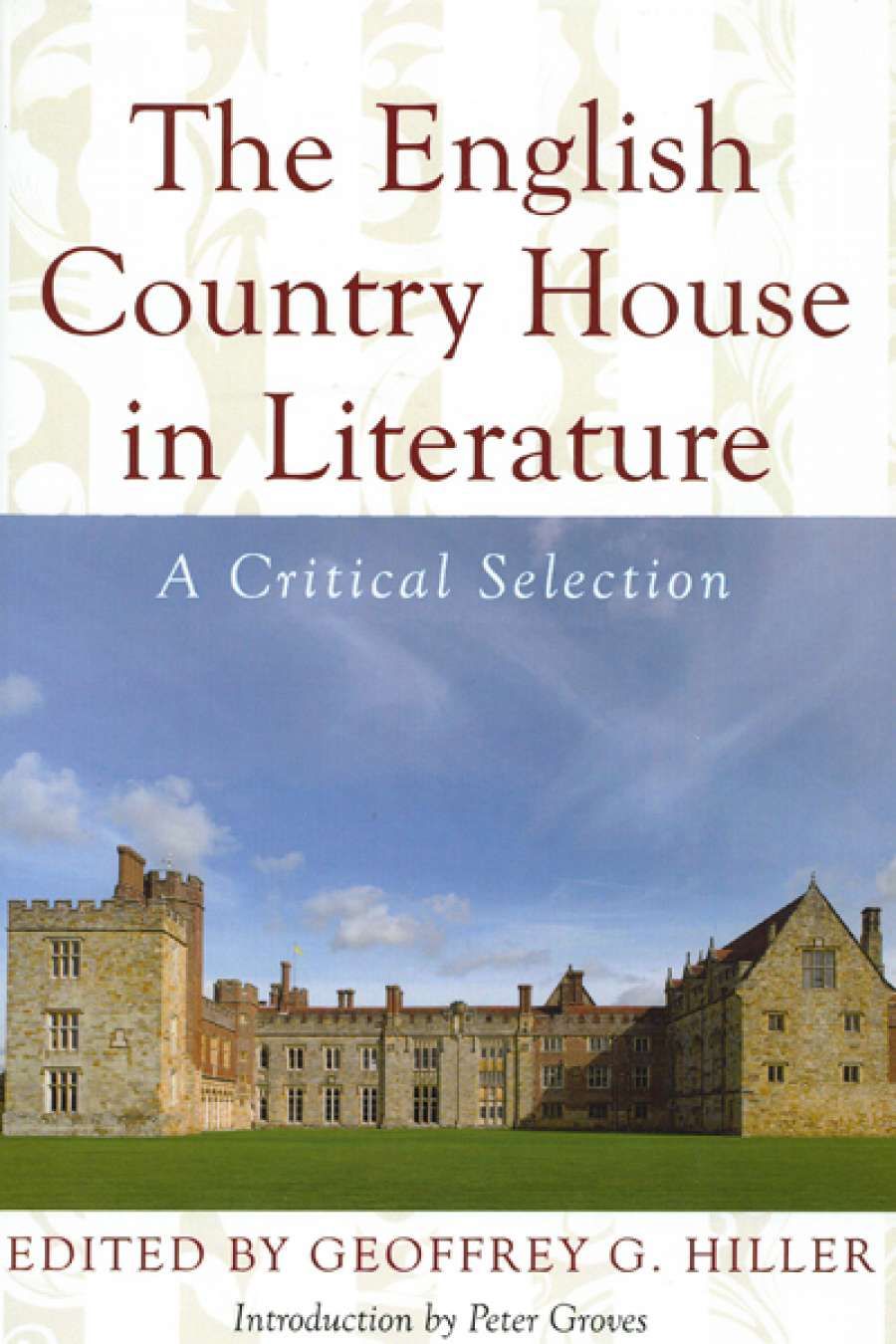
- Free Article: No
- Contents Category: History
- Custom Article Title: Sarah Dempster reviews 'The English Country House in Literature' edited by Geoffrey G. Hiller
- Book 1 Title: The English Country House in Literature
- Book 1 Subtitle: A Critical Selection
- Book 1 Biblio: Monash University Press, $59.95 hb, 335 pp, 9781922235299
Such an uneasy landscape is manifested early in Hiller's volume in the form of an extract from Edmund Spenser's The Faerie Queene (1590). Spenser's Redcrosse Knight is taken to the unmistakably metaphorical home of Lucifera, known as The House of Pride. The house is ostentatious in its design and adornment, embodying 'endlesse richesses' and 'sumptuous shew'. Yet, the narrator laments, it stands on a 'weake foundation ... that every breath of heaven shaked itt'. Luxurious decoration is mistakenly privileged over a strong foundation, an affront to heaven and godliness within the English landscape.
On the next page, and juxtaposed with such hollowness and excess, is a second Spenserian extract from The Faerie Queene depicting The House of Holinesse, presided over by the pious Caelia. In contrast, this home embodies humility, virtue, and Christian love. The house is 'both plaine, and pleasaunt to be walked in', and the simplicity of its architectural features act as a metonym for the self-effacing country gentleman who dwells there, a 'gentle Squyre, / Of myld demeanure, and rare courtesee'. His virtues of modesty and courtesy are complemented by Caelia's desire to 'relieve the needes / Of wretched soules, and helpe the helplesse pore', spending her days doing 'good and godly deedes' for the benefit of the community which encircles their estate.
 Chatsworth House in Derbyshire stood in for Pemberley in the 2005 film adaptation of Jane Eyre (photograph by Tom Pennington via Wikimedia Commons)
Chatsworth House in Derbyshire stood in for Pemberley in the 2005 film adaptation of Jane Eyre (photograph by Tom Pennington via Wikimedia Commons)
Hiller's anthology extends from the seventeenth into the eighteenth century, featuring extracts from Alexander Pope's 'Epistle IV: To Richard Boyle, Earl of Burlington' (1731), Henry Fielding's Tom Jones (1749), and Tobias Smollett's The Expedition of Humphry Clinker (1771). When we finally arrive in the nineteenth century with Jane Austen's familiar Pride and Prejudice (1813), the house of Pemberley emerges from the landscape. With an absence of garish art, Mr Darcy's grand house helps Elizabeth reconsider both his character and his love.
In Hiller's volume, it is interesting to note that many examples of nineteenth-century literature reinforce commonplace ideas about country houses. Aside from the offering by Benjamin Disraeli that describes Coningsby Castle as a disordered attempt at country life, where 'nobody came down to breakfast' and 'the ladies were scarcely seen until dinner time' (Coningsby, 1844) the romanticism, stateliness, and organisation of country houses dominate literary representation, and inform many modern conceptions of the English country house.
'While the story of the English country house is certainly steeped in nostalgia and privilege, it is also a narrative of exclusion, exploitation, and decline'
Moreover, it is around this juncture in Hiller's book that the reader will perhaps mark the fascinating imprints of long-absent human figures in the country house landscape. Charlotte Brontë's Thornfield Hall in Jane Eyre (1847) is decorated by 'half-effaced embroideries, wrought by fingers that for two generations had been coffin-dust'. In Charles Dickens's Bleak House (1853), the narrator is struck by the 'half-length portraits' which 'abounded all through the house'. Here, portraits of ancestors are given equal significance to other domestic adornments, comprising 'all the moveables, from the wardrobes to the chairs and tables, hangings, glasses, even to the pincushions and scent-bottles on the dressing-tables'. In short, the country house endures long after the diminutive figures within have vanished.
Therefore, P.G. Wodehouse's satire of the country house genre in Something Fresh (1915) is a welcome respite from the spectral world of nineteenth-century country houses. Lord Emsworth's 'extremely sketchy notions of the duties of a host' playfully satirise the modest country gentleman of the genre. In fact, the early twentieth-century extracts in Hiller's volume principally expound satire and decline as the country house becomes a waning institution in Evelyn Waugh's Decline and Fall (1928), Christopher Isherwood's The Memorial (1932), W.H. Auden and Christopher Isherwood's The Dog Beneath the Skin (1935), and Virginia Woolf's Between the Acts (1941). All of these extracts speak of stagnation, the disunity of humanity, misinterpretation, and dissonance.
'The reader will perhaps mark the fascinating imprints of long-absent human figures in the country house landscape'
Arriving at Brideshead Revisited (1945), the figure of Charles Ryder gives a fitting eulogy for the magical house of Brideshead. He observes that, 'more than the work of the great architects, I loved the buildings that grew silently with the centuries, catching and keeping the best of each generation'. Such nostalgia remains in the later twentieth-century extracts in the modern territory of Kazuo Ishiguro's Remains of the Day (1989), Ian McEwan's Atonement (2001), and Sarah Waters's The Little Stranger (2009), where romance, tragedy, and the relentless passage of time evoke unequivocal pathos.
Hiller's anthology imbues a modern reader with the facility to study the ideologies, social functioning, and decline of these institutions, in order to consider why country houses have endured. The English country house continues to live large in the collective imagination, and Hiller's work offers an apt way for a reader to consider the boundaries between mythology, nostalgia, and history.


Comments powered by CComment